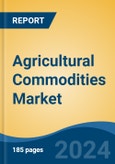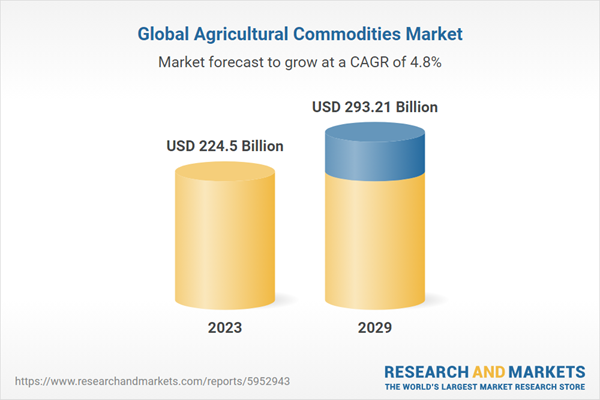Speak directly to the analyst to clarify any post sales queries you may have.
10% Free customizationThis report comes with 10% free customization, enabling you to add data that meets your specific business needs.
Key commodities include grains like wheat, corn, and rice, which form the staple diet for billions worldwide. Commodities such as soybeans, sugar, coffee, cocoa, and livestock play critical roles in diets and industries globally. The market's dynamics are influenced by various factors, including weather patterns, geopolitical events, government policies, and technological advancements.
The globalization of trade has further transformed the agricultural commodities market, facilitating the flow of goods across borders but also exposing it to risks associated with economic instability and trade disputes. Concerns about sustainability, environmental impact, and food security have increasingly shaped market dynamics, driving demand for ethically sourced, environmentally friendly products.
Key Market Drivers
Growth in Agriculture Industry
As the global population continues to expand, so does the demand for food. Dietary shifts in emerging economies towards more protein-rich diets, along with urbanization, further boost the demand for agricultural commodities like grains, livestock, and dairy products.Despite concerns about land degradation and environmental sustainability, the agricultural industry continues to expand, particularly in developing countries. This expansion involves the conversion of forests or marginal lands into agricultural fields and the intensification of farming practices, leading to higher yields and greater production of commodities like soybeans, palm oil, and corn.
Beyond food and feed, agricultural commodities serve as inputs for various industrial applications, including biofuels, textiles, and bio-based materials. The growing interest in renewable energy sources drives demand for biofuels derived from crops like corn, sugarcane, and soybeans. The development of bio-based plastics and other sustainable materials expands the market for agricultural feedstocks, stimulating growth in the industry.
Surge in Technological Advancements
The surge in technological advancements has emerged as a significant driver reshaping the landscape of the global agricultural commodities market. This transformation is characterized by a convergence of various innovative technologies, including precision agriculture, biotechnology, big data analytics, and automation, among others.One of the key impacts of technological advancements in agriculture is the optimization of production processes. Precision agriculture, enabled by technologies such as GPS, drones, and sensors, allows farmers to monitor and manage their crops with unprecedented precision. By precisely tailoring inputs such as water, fertilizers, and pesticides to the specific needs of each plant, farmers can enhance yields, reduce waste, and improve resource efficiency. This increased productivity contributes to the availability of agricultural commodities in the global market, influencing supply and demand dynamics.
Biotechnological innovations have led to the development of genetically modified organisms (GMOs) and advanced breeding techniques, which offer crops with enhanced traits such as drought tolerance, pest resistance, and increased nutritional value. These genetically modified crops have the potential to boost yields and mitigate the impact of environmental stressors, thereby influencing the global supply of agricultural commodities.
Key Market Challenges
Growing Concern for Food Security and Nutrition
The growing concern for food security and nutrition represents a significant challenge within the Global Agricultural Commodities Market. One of the primary facets of this challenge is the persistence of food insecurity, which affects individuals, households, and entire communities. Food insecurity manifests in different forms, ranging from chronic hunger and under nutrition to food shortages caused by sudden crises such as conflicts, natural disasters, or economic downturns. Vulnerable populations, including children, women, and the elderly, are particularly at risk of malnutrition and its long-term consequences on health and development.Nutrition insecurity is another dimension of the challenge, characterized by inadequate access to diverse and nutrient-rich foods essential for healthy diets. Poor dietary quality, micronutrient deficiencies, and the consumption of unhealthy processed foods contribute to the global burden of malnutrition, including stunting, wasting, and obesity. Malnutrition not only affects physical health but also hampers cognitive development, productivity, and economic growth, perpetuating cycles of poverty and inequality.
The Global Agricultural Commodities Market plays a crucial role in addressing food security and nutrition challenges by providing essential commodities such as grains, fruits, vegetables, dairy, and protein sources. The market's dynamics, including price volatility, trade barriers, and unequal distribution channels, can exacerbate food insecurity and hinder access to nutritious foods, especially for vulnerable populations in low-income countries and regions.
Key Market Trends
Growing Adoption of Hydroponics
Hydroponic systems allow for precise control over growing conditions, including nutrient levels, pH balance, and water usage. By providing optimal conditions for plant growth, hydroponics can significantly increase crop yields compared to conventional soil-based farming. This heightened efficiency in production contributes to a greater supply of agricultural commodities in the market.Hydroponic farming uses significantly less water compared to traditional soil-based agriculture, making it well-suited for regions facing water scarcity or drought conditions. Hydroponic systems can be implemented vertically or in controlled indoor environments, requiring less land area than traditional farms. This conservation of resources aligns with sustainability goals and reduces the environmental footprint of agricultural production.
Hydroponic farming is particularly well-suited for urban agriculture initiatives and local food systems. Vertical hydroponic systems can be implemented in urban spaces such as rooftops, vacant lots, or repurposed buildings, enabling communities to produce fresh, locally grown food in densely populated areas. The proximity of hydroponic farms to urban centers reduces transportation costs and carbon emissions associated with food distribution, further enhancing sustainability.
Segmental Insights
Type Insights
Based on the category of type, the soft emerged as the fastest growing segment in the global market for agricultural commodities in 2023. There is an increasing demand for healthier and more diverse diets worldwide. Soft commodities like fruits, vegetables, nuts, and specialty crops are often associated with health benefits, driving consumer preferences towards these products.Advances in agricultural technology, including precision farming techniques, improved irrigation systems, and pest management practices, are enhancing the productivity and quality of soft commodities. These technological innovations are enabling producers to meet the demands of a growing market more efficiently.
Product Type Insights
The corn segment is projected to dominate the market during the forecast period. Corn is one of the most versatile crops, with a wide range of uses across various industries. It is not only a staple food in many parts of the world but also serves as a feedstock for livestock, a raw material for the production of ethanol and other biofuels, and a key ingredient in numerous industrial products such as corn syrup, starch, and bio-based plastics. This versatility ensures a consistent demand for corn in both food and non-food sectors, driving its prominence in the global market.Corn has relatively high yield potential compared to other cereal crops, such as wheat or rice. Modern agricultural practices, including advancements in seed technology, fertilization, and crop management techniques, have further increased corn yields, making it a profitable crop for farmers. The high productivity of corn contributes to its dominance in global agricultural production and trade.
Regional Insights
North America emerged as the dominant player in the Global Agricultural Commodities Market in 2023, holding the largest market share in terms of value. North America possesses vast expanses of arable land and a diverse range of climates suitable for cultivating a wide variety of crops. This allows for high productivity and diversity in agricultural output.North American agriculture benefits from significant investments in research and development, leading to the adoption of advanced farming techniques, machinery, and technologies. This has resulted in increased efficiency, productivity, and competitiveness in the global market.
Report Scope:
In this report, the Global Agricultural Commodities Market has been segmented into the following categories, in addition to the industry trends which have also been detailed below:Agricultural Commodities Market, By Type :
- Hard
- Soft
Agricultural Commodities Market, By Trading Type :
- Online
- Offline
Agricultural Commodities Market, By Product Type :
- Soybeans
- Corn
- Wheat
- Rice
- Cocoa
- Coffee
- Cotton
- Spices
- Oil Seed
- Sugar
- Meat
- Dairy Products
- Others
Agricultural Commodities Market, By Region:
- North America
- United States
- Canada
- Mexico
- Europe
- France
- United Kingdom
- Italy
- Germany
- Spain
- Asia Pacific
- China
- India
- Japan
- Australia
- South Korea
- South America
- Brazil
- Argentina
- Colombia
- Middle East Africa
- South Africa
- Saudi Arabia
- UAE
Competitive Landscape
Company Profiles: Detailed analysis of the major companies present in the Global Agricultural Commodities Market.Available Customizations:
Global Agricultural Commodities Market report with the given market data, the publisher offers customizations according to a company's specific needs.This product will be delivered within 1-3 business days.
Table of Contents
Companies Mentioned
- Archer Daniels Midland Company
- AGROPECUARIA MAGGI LTDA
- Bunge Global SA
- Cargill, Incorporated
- Golden Agri-Resources Ltd
- JBS USA Food Company Holdings
- Louis Dreyfus Company B.V.
- Olam Group Limited
- Wilmar International Limited
- Marfrig Global Foods SA
Table Information
| Report Attribute | Details |
|---|---|
| No. of Pages | 185 |
| Published | April 2024 |
| Forecast Period | 2023 - 2029 |
| Estimated Market Value ( USD | $ 224.5 Billion |
| Forecasted Market Value ( USD | $ 293.21 Billion |
| Compound Annual Growth Rate | 4.7% |
| Regions Covered | Global |
| No. of Companies Mentioned | 10 |









